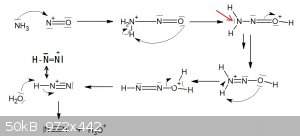Increasing Wordiness
Harmless

Posts: 7
Registered: 9-4-2016
Member Is Offline
Mood: No Mood
|
|
The decomposition of Nitrogen monoxide with ammonia
I predict that ammonia react with NO to form nitrogen and H3O+. There is one step that I forgot to write out, this might be a
good alternative for urea.
However, it will form a foggy corrosive fog, don't try it in your underground homelab as smoke detectors will go in alarm. Just my experience to try
it outside.
Bromine and ammonia react in a similar fashion which is a clever idea if things go wrong.
Can someone check this mechanism out ?
btw:
I forgot one step, the red arrow is pointing to the lone pair that will shift to the right, I think...

|
|
|
Nicodem
|
Thread Moved
10-4-2016 at 04:38 |
Increasing Wordiness
Harmless

Posts: 7
Registered: 9-4-2016
Member Is Offline
Mood: No Mood
|
|
This is placed in the wrong section, however if the mechanism is right then ammonia could be replaced by R-MgX in ether to perform a Grignard reaction
with nitrogen monoxide. The R group must be long enough so that a liquid or solid is formed instead of a gas.
The end product is a oxime if it works. I couldn't find much information, a moisture free and inert atmosphere must be used to avoid the formation of
nitrogen dioxide. Any experience or feedback about this hypothetical procedure is really appreciated !
Note: R-MgX doesn't react with butyl nitrite since this molecule is too stable in a alkaline mixture and doesn't react.
|
|
|
Metacelsus
International Hazard
    
Posts: 2531
Registered: 26-12-2012
Location: Boston, MA
Member Is Offline
Mood: Double, double, toil and trouble
|
|
The reaction:
NH3 + NO -> N2 + H3O+
isn't balanced for charge, so it can't happen.
If oxygen is present, the reaction will be:
4 NH3 + 4 NO + O2 -> 4 N2 + 6 H2O
If oxygen is not present, the reaction will be:
4 NH3 + 6 NO -> 5 N2 + 6 H2O
Both of these reactions require a catalyst and 400 °C.
Reference:
http://pubs.acs.org/doi/abs/10.1021/j100311a016
[Edited on 4-10-2016 by Metacelsus]
|
|
|
Increasing Wordiness
Harmless

Posts: 7
Registered: 9-4-2016
Member Is Offline
Mood: No Mood
|
|
If I went to the university then the reaction mechanism for diazotisation begins with the formation of +NO.
Source:
Reaction of HONO
|
|
|
vmelkon
National Hazard
   
Posts: 669
Registered: 25-11-2011
Location: Canada
Member Is Offline
Mood: autoerotic asphyxiation
|
|
That's not nitrogen monoxide. I don't know what the name is for that (NO+ with the + charge on the nitrogen). Looks like you need to do the reaction
in water. Add NaNO2 to water and add a acid like HCl to form HNO2.
I think your 2nd product (after the 2nd arrow) is wrong. You have a + charge on a O.
I think what will happen is that a H will leave as a H+ and you will have H2N-NO.
Then one of the H moves to the O, you get HN-NOH.
An H+ can attach to the O, you get HN-NOH+H.
An H2O breaks off, you get HN-N+.
An H+ breaks off, you get N-N.
[Edited on 11-4-2016 by vmelkon]
Signature ==== Is this my youtube page? https://www.youtube.com/watch?v=tA5PYtul5aU
We must attach the electrodes of knowledge to the nipples of ignorance and give a few good jolts.
Yes my evolutionary friends. We are all homos here. |
|
|
Metacelsus
International Hazard
    
Posts: 2531
Registered: 26-12-2012
Location: Boston, MA
Member Is Offline
Mood: Double, double, toil and trouble
|
|
Quote: Originally posted by vmelkon  | | That's not nitrogen monoxide. I don't know what the name is for that (NO+ with the + charge on the nitrogen). |
It's the nitrosyl cation, also known as the nitrosonium cation:
https://en.wikipedia.org/wiki/Nitrosonium
(The positive charge isn't all on the nitrogen; there's another resonance form with it on the oxygen.) If that were reacting with ammonia, then the
reaction would proceed as the OP described.
[Edited on 4-11-2016 by Metacelsus]
|
|
|